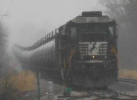Arctic Cat ZRT wrote:In terms of steer-able trucks, from what I know, they basically allow larger 6 axle locomotives to operate on tight radius tracks. Having 3 axles per truck limits how tight the turn could be before the train either derails, damages something, etc. A 4 axle locomotive can negotiate a much tighter radius than a 6 axle, obviously. The steerable truck allows for the wheels to pivot in the truck so that they can move to accommodate a tighter radius like radius's that only 4 axle locomotives could operate on perviously, allowing the 6 axle locomotive to operate on a wide variety of radius's in a railroad's service area, saving money.
This is what I know about that type of truck, if someone wants to add or correct me, go right ahead!
I guess those would be useful on railroads with old trackage designs still in use, when 6 wheel bogies weren't common... Also, what is the visual difference? Now I actually understand the functional difference, but what are the things to look for in a locomotive to decide if it's trucks are steerable?



 , Kevin, now I know what I'm looking for
, Kevin, now I know what I'm looking for 



